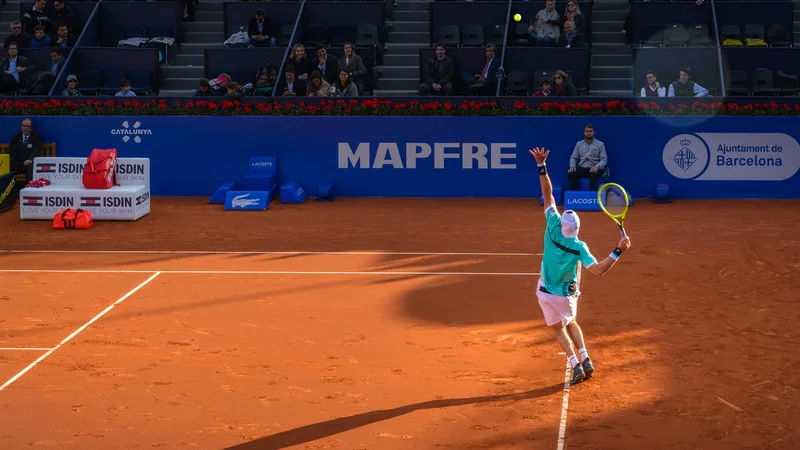
The most recognizable tennis court surfaces are acrylic and polyurethane hard courts, clay, and grass. These are the well-known tennis surfaces we see the tennis professionals play on during the ATP Tour.
Surprisingly, there are many different tennis surfaces that most of us are not aware of. Here are the different tennis surfaces in tennis found across the world today.
The 11 Different IFT Approved Surfaces In Tennis:
- Grass
- Clay
- Hard (Acrylic And Polyurethane)
- Artificial Grass
- Artificial Clay
- Asphalt
- Concrete
- Hybrid Clay
- Carpet
- Tile
- Wood
However, the ATP Tour only uses clay, hard, and grass courts during a season.
Let’s go through all the different surfaces in more detail.
1. Grass
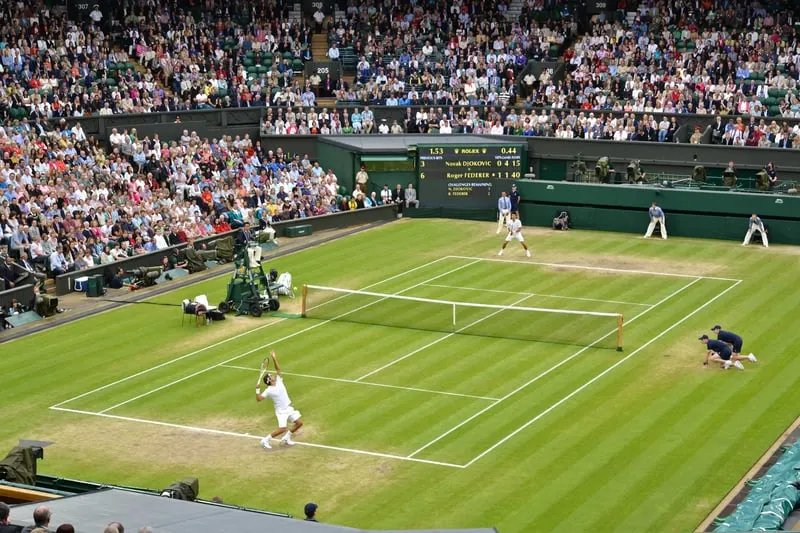
Tennis originated on grass courts when amateur players entered the first “Wimbledon Championship” hosted by the All England Lawn Tennis and Croquet Club in 1877.
Grass courts typically consist of ryegrass, known for being the fastest-playing tennis courts and the most difficult to maintain as it needs to be sowed, mowed, and fertilized while controlling weeds. It’s also by far the hardest surface to play tennis on.
The grass courts at Wimbledon commonly referred to as the most prestigious Grand Slam in tennis, are sown with 100% perennial ryegrass. Originally, the Australian Open and US Open were contested on grass until 1988 and 1975, respectively. There are less than 500 grass courts in the US today.
With grass courts making up 1% of national tennis courts in the US, you may wonder where you can play on grass. Private clubs such as Longwood Cricket Club in Chestnut Hill in Massachusetts, the West Side Tennis Club at Forest Hills in Queens, and the Merion Cricket Club outside Philadelphia feature grass tennis courts.
The recently retired “King of Grass” Roger Federer is the best grass court player of all time:
- 8 Wimbledon Championships
- 19 Tour Level Grass Titles
- 192 Grass Court Wins
- Record 65-Match Winning Streak On Grass (2003 to 2008)
2. Clay
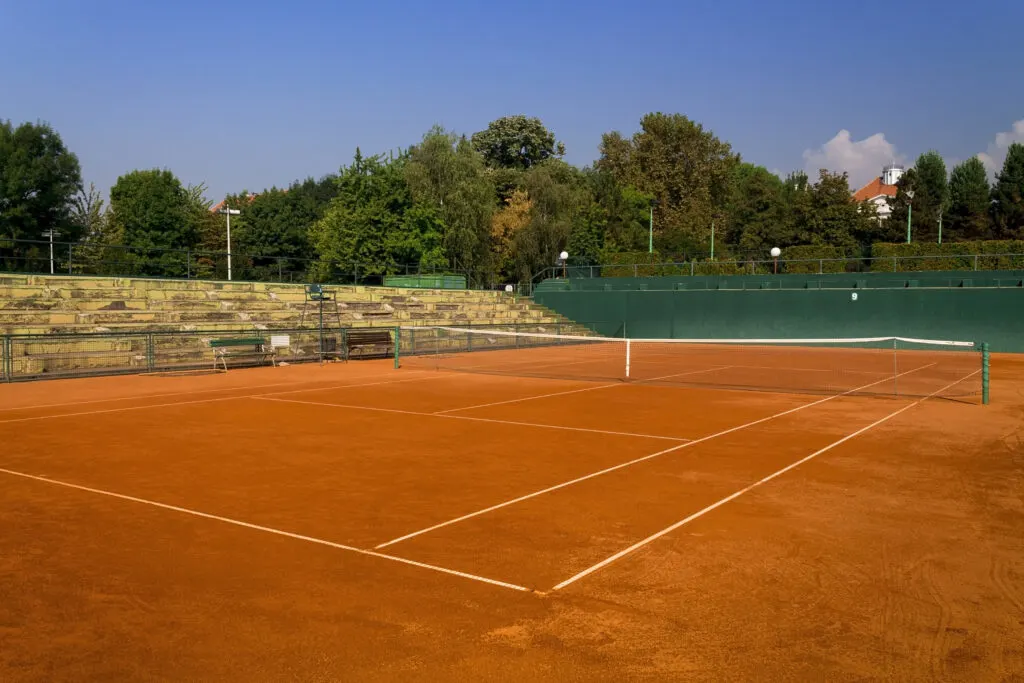
Clay courts are constructed in layers that measure 30′ in depth. The first level is made of stones, then a gravel level, clinker (volcanic residue), and limestone, followed by a thin top layer of crushed brick and stone, which gives the court its iconic red hue.
The iconic red clay courts of Stade Roland Garros in Paris, France, are the most popular and the location of the second Grand Slam of the year. Clay is considered the slowest tennis surface and is extremely popular in Europe and South America.
The US has green clay, which goes by brand names like Har-Tru and Rubico, which is made of crushed meta basalt instead of bricks. Due to being harder than crushed brick, it tends to play faster than the traditional red clay courts.
Rafael Nadal, universally referred to as the “King of Clay,” holds numerous clay records, and his 14 Roland Garros titles will stand the test of time:
- 91.3% Win Record On Clay (W:475 L:45)
- 97.3% Win Record At Roland Garros (2005 to 2022)
- Record 63 Clay Court Titles
3. Hard Courts (Acrylic Or Polyurethane)
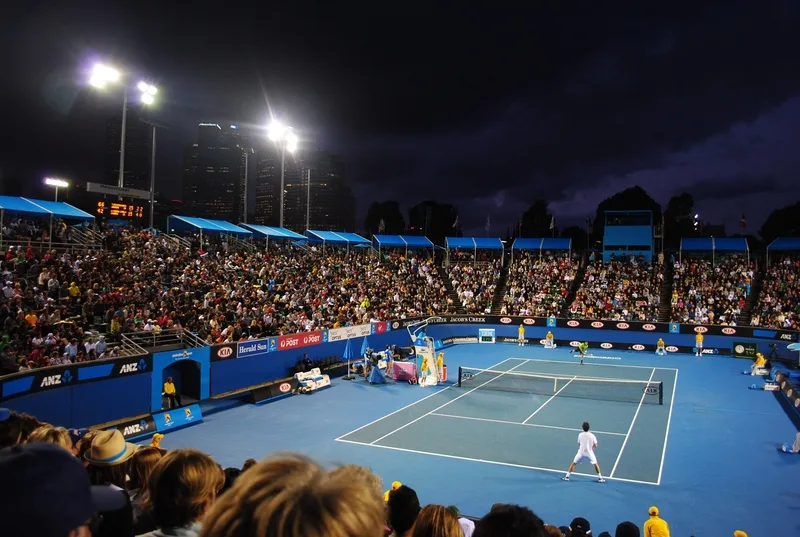
Hard courts consist of a base of concrete or asphalt topped with a layer of acrylic or polyurethane. Depending on the speed requirement of the court, a layer of foam can be added underneath the top layer. The court gets slower when sand is added to the paint used to cover the court surface.
Two of the tennis world’s Grand Slams are played on hard courts, and this type of court is the most popular type of court in the USA. Most courts with acrylic or polyurethane surfaces are classified as either medium, medium-fast, or fast-playing surfaces.
Most of the biggest professional tournaments, like the Australian Open, US Open, ATP Finals, and 6 ATP 1000s, are played on courts made of acrylic or polyurethane, such as Miami, Indian Wells, Canadian Open, Cincinnati, Paris, and Shanghai.
Novak Djokovic is one of the top performers when it comes to the hard ‘acrylic and polyurethane’ courts, and 12 of his 21 Grand Slams came on the harder surfaces:
- 9 Australian Opens
- 3 US Opens
- 84.4% Win Record On Hard Courts
4. Artificial Grass
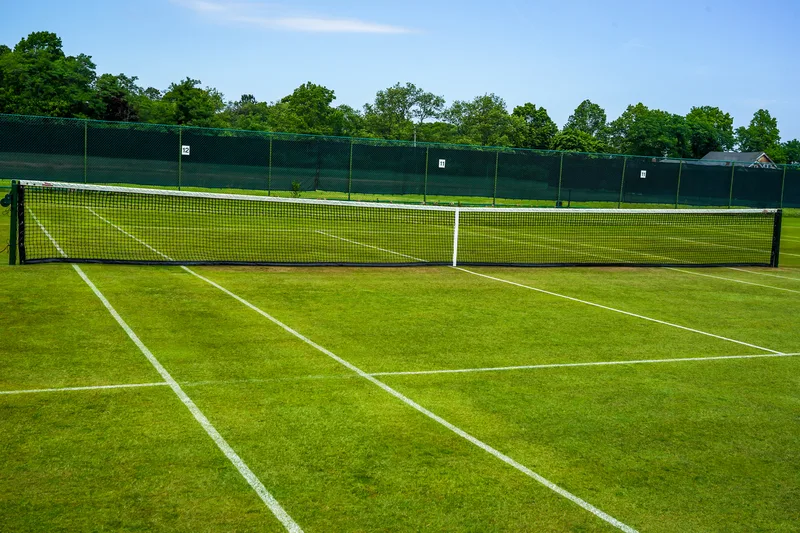
An artificial or synthetic grass court consists of a sub-base of free-draining primary aggregate (Type Three Stone), a porous asphalt base layer that controls temperature, and a roll of artificial grass on top of it.
Many tennis clubs in the US are using artificial grass courts as it’s easy to install and low-maintenance. The risk of playing on clay courts, due to ever-moving clay material, and hard courts being tough on a player’s joints, is negated when playing on the soft artificial grass, which reduces stress on the body.
The popularity of artificial grass courts is on the rise. The Guardian has recently reported that Wimbledon’s head of courts and horticulture, Niel Stubley, has indicated that they are testing the stitching of artificial grass fibers with real grass.
Artificial grass-type solutions are necessary to ensure that Wimbledon-style grass courts are viable in other countries with variable climates, to extend the grass court season in the UK, and to ensure that grass courts around the world don’t die out.
5. Artificial Clay

Artificial clay courts are constructed by laying a special carpet (mono-filament artificial fibers) as its base that replaces the layer of finely crushed aggregate used to construct a regular clay court. A layer of clay or sand is added on top of the carpet base, which mimics the feel of a standard clay court.
Artificial clay courts are meant to replicate a regular clay surface but without exhaustive maintenance requirements, such as watering and rolling.
Players can slide on these courts, but there is a noticeable difference in bounce which is much lower than on regular clay courts.
An artificial clay tennis court’s top layer never contracts and requires little to no maintenance besides a good brush at the end of the day’s play. Artificial clay courts are designed with excellent drainage and aren’t as heavily impacted by rain as natural clay courts.
6. Asphalt
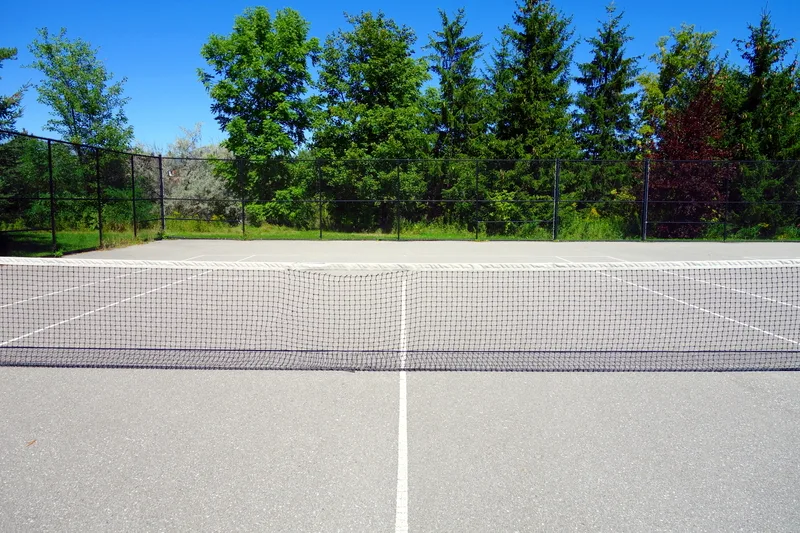
Asphalt courts, as you may have guessed, are made from asphalt. The initial cost to install an asphalt tennis court is much lower than any other type of surface. Asphalt courts are typically used when public courts are built.
Due to not including an acrylic or polyurethane layer as a top coat, the surface is known to crack, which can increase long-term cost where repairs and maintenance is concerned.
7. Concrete
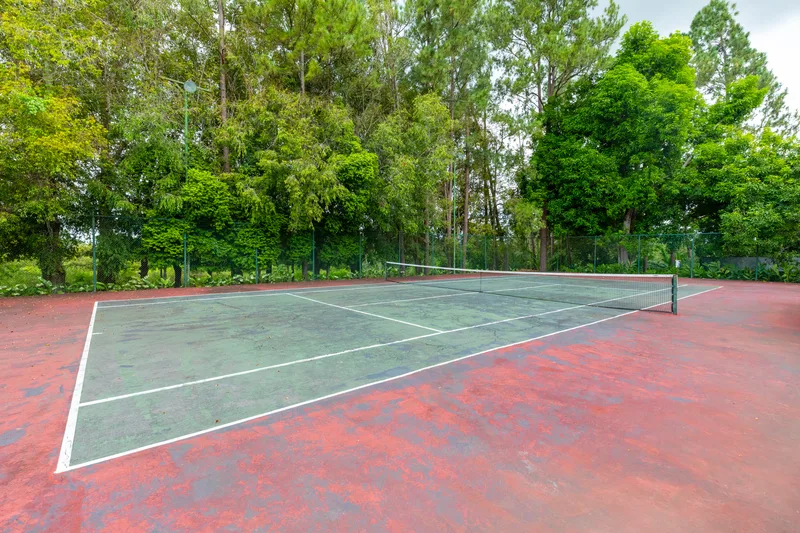
Concrete courts are made out of concrete, an upgrade to asphalt courts, as they aren’t as prone to cracking.
The court is typically painted on the concrete, or the whole concrete area is painted the same color, with the white court lines indicating the play area.
8. Hybrid Clay

Hybrid clay surfaces are a trademarked technology that the IFT has recently recognized as a new playing surface, rated as slow. The main feature of hybrid clay is that you can install it over any surface or existing court.
The construction process is kept under wraps at present due to trademark rights, but companies like HYBRIDCLAY claim the following benefits:
- Made From Imported European Red Clay
- Equal Friction And Restitution
- Frostproof
- Wind Resistant
- No Rolling Required
- No Foot Holes
- Soft Courts
- No Line Adjusting
- No Stamping
- 80-90% Less Maintenance
- Behaves Like A European Clay Court
Tennis court supplier, Vigano Pavitex, describes its ITF-approved TOP CLAY courts as a “needle punch tennis surface with a support layer of 100% structured polypropylene fiber with total impregnation, in-filled with crushed brick clay.”
9. Carpet
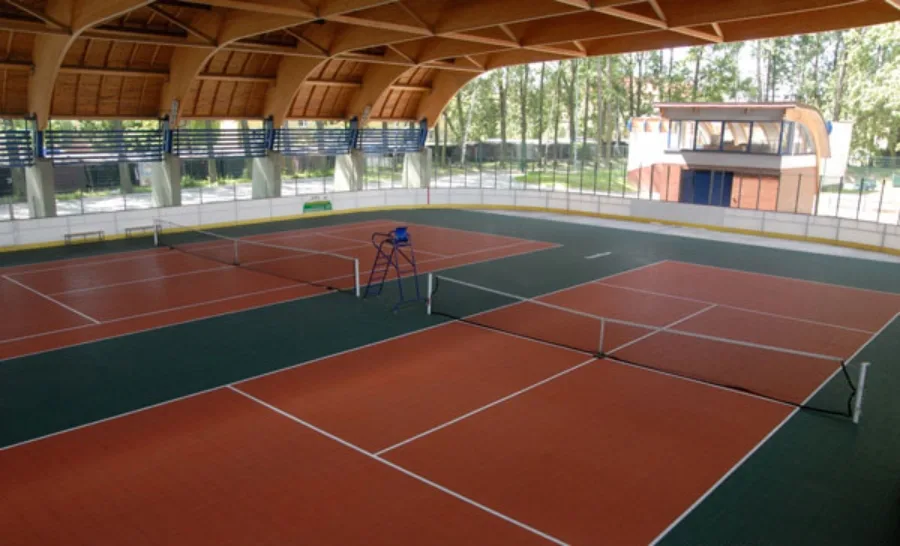
Carpet courts are similar in construction to hard courts. An asphalt layer is covered with a special carpet (textile or polymeric material), typically manufactured in rolls. A carpet court is a fast surface suited for players with massive serves and powerful groundstrokes.
Carpet courts were part of the ATP roster until 2009 when their use was demoted to the Challenger Series and ITF circuit-level competitions. The ATP 1000 Paris Masters and ATP Finals were some elite tennis tournaments featuring carpet-surfaced courts.
10. Tile
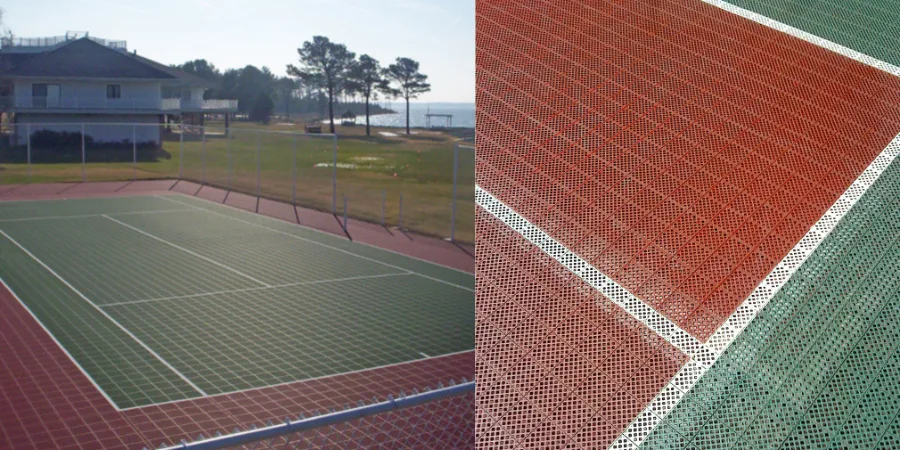
A less talked about tennis court surface is tile (constructed with interlocking tennis court tiles). These tiles are used on a solid asphalt or concrete base, or even dirt or grass, combining the comfort of a soft court with the durability of a hard court, with little to no maintenance.
Tile surfaces are rarely used by serious tennis players, even though it’s one of the ITF-approved surfaces.
11. Wood
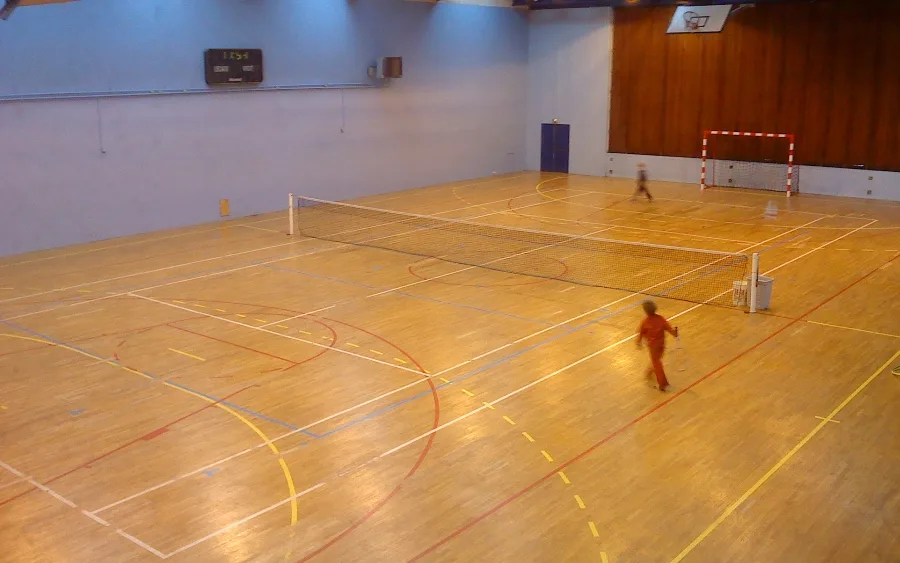
Wood tennis courts were popular back in the day and are widely acknowledged to be the fastest surface to play tennis on. Suppose you find a hardwood tennis court. Be prepared for a serious test of your reflexes as it’s super-fast, and even a kick-serve can ace you.
In 2018, the New York Open decided to have players compete on a court made out of black hardwood imported from Germany, with some foam panels underneath, topped off with a cement-like paint. South African Kevin Anderson won the tournament.
